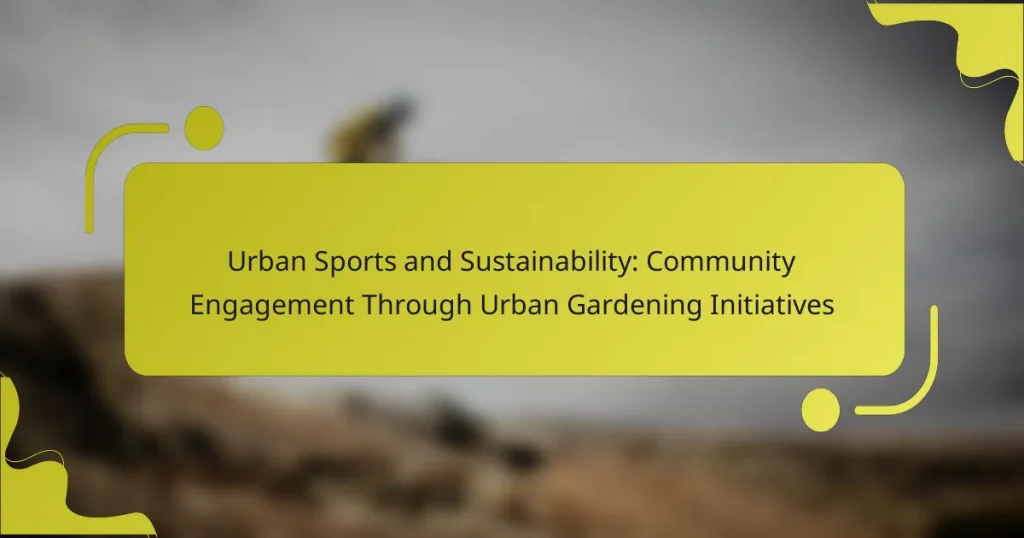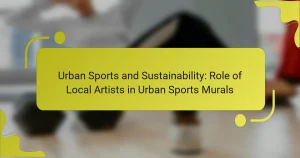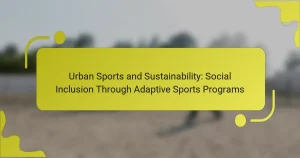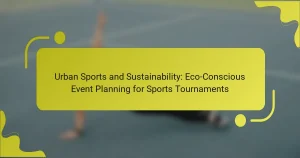Urban sports can significantly enhance community engagement through urban gardening initiatives. These projects foster collaboration and environmental awareness while improving mental health and reducing crime rates. By integrating sustainable practices into sports events, communities can create green spaces that promote biodiversity and enhance urban ecosystems. Innovative approaches, such as community-led gardening projects and educational workshops, further support inclusivity and resource allocation.
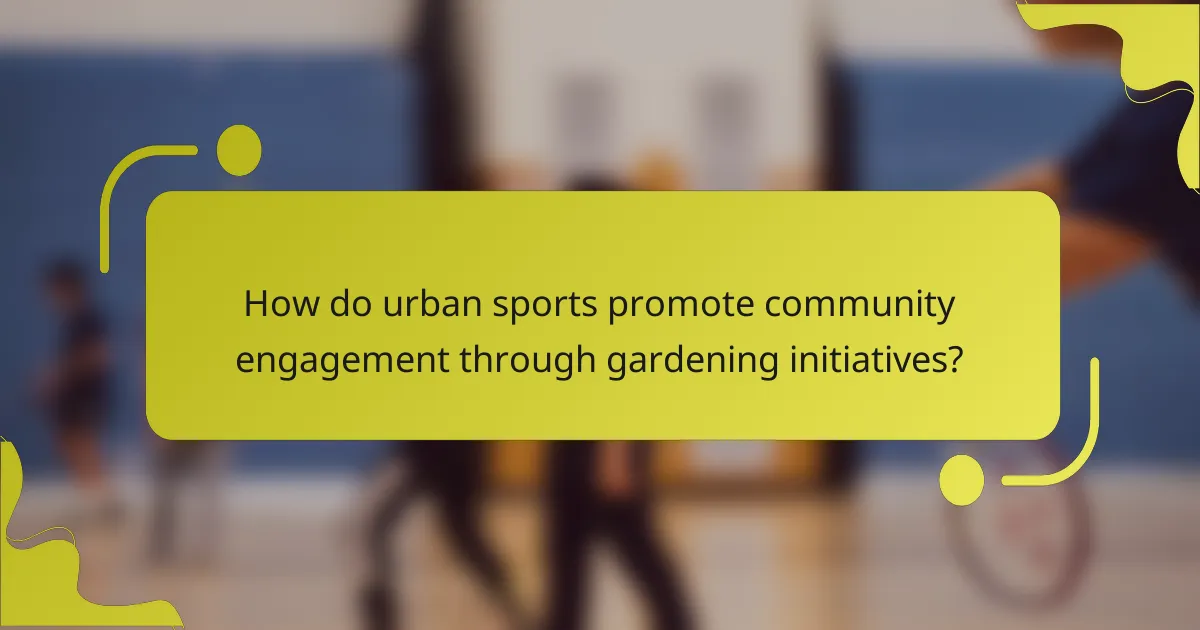
How do urban sports promote community engagement through gardening initiatives?
Urban sports promote community engagement through gardening initiatives by fostering collaboration and environmental awareness. These activities encourage participants to work together, enhancing social connections. Urban gardening projects linked to sports events often involve local residents, creating a sense of ownership and pride in shared green spaces.
Research shows that community gardens can reduce crime rates and improve mental health, as they provide safe, welcoming environments. Additionally, urban sports events can serve as platforms for promoting sustainable practices, such as composting and water conservation, further integrating ecological responsibility into community engagement efforts.
By blending physical activity with environmental stewardship, urban sports not only enhance community ties but also contribute to a healthier urban ecosystem. This unique approach cultivates both social and ecological benefits, making urban gardening an essential component of sustainable community development.
What role do urban sports play in fostering social connections?
Urban sports foster social connections by engaging communities in collaborative activities. Participants bond over shared interests, enhancing social cohesion. Urban sports also encourage inclusivity, allowing diverse groups to interact. Initiatives like urban gardening further strengthen these connections by providing communal spaces for teamwork and shared goals. These interactions promote a sense of belonging and community pride.
How can gardening initiatives enhance the urban sports experience?
Gardening initiatives can significantly enhance the urban sports experience by fostering community engagement and promoting sustainability. These initiatives create green spaces that serve as venues for both recreational activities and urban sports events. They encourage collaboration among community members, leading to stronger social ties and increased participation in local sports.
Urban gardening can provide essential resources, such as fresh produce and natural aesthetics, which contribute to healthier lifestyles. Studies indicate that access to green spaces can improve physical and mental well-being, positively influencing sports participation rates. Furthermore, these initiatives can serve as platforms for organizing sports-related events, workshops, and activities that unite diverse community groups.
As a result, urban gardening initiatives not only beautify neighborhoods but also create a supportive environment for urban sports, fostering a culture of health and community involvement.
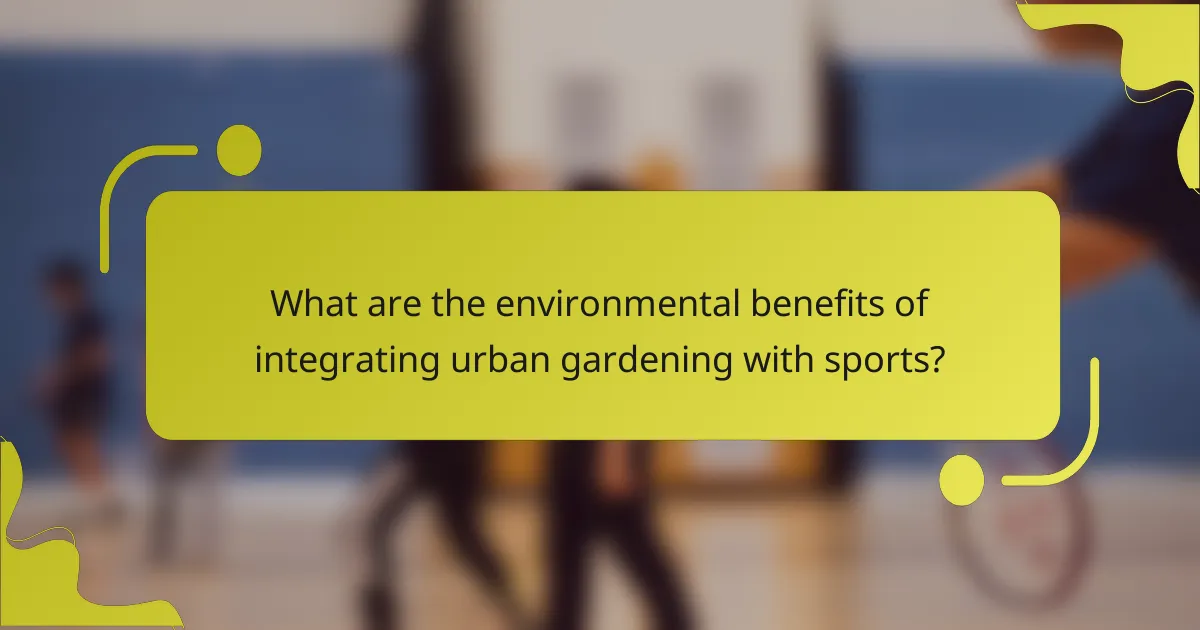
What are the environmental benefits of integrating urban gardening with sports?
Integrating urban gardening with sports provides significant environmental benefits, enhancing urban ecosystems. It promotes biodiversity by creating habitats for various species and improves air quality through increased vegetation. Urban gardens also mitigate urban heat effects, reducing energy consumption. Furthermore, they contribute to stormwater management, decreasing runoff and promoting groundwater recharge.
How does urban gardening contribute to biodiversity in cities?
Urban gardening significantly enhances biodiversity in cities by creating habitats for various species. These initiatives promote ecological balance through increased plant diversity, which attracts pollinators and other wildlife. Urban gardens can host native plants, supporting local ecosystems and providing food sources for birds and insects. Additionally, they contribute to soil health and air quality, fostering a sustainable urban environment. Community engagement in these projects further strengthens connections between residents and nature, encouraging stewardship and awareness of biodiversity.
What impact does urban gardening have on air quality and urban heat?
Urban gardening significantly improves air quality and reduces urban heat. Plants absorb carbon dioxide and release oxygen, enhancing air purity. They also provide shade, lowering surface temperatures and mitigating the urban heat island effect. Studies show that urban gardens can decrease local temperatures by up to 5 degrees Fahrenheit. Additionally, they filter pollutants, contributing to healthier urban environments. Engaging communities in urban gardening fosters environmental awareness and promotes sustainable practices, creating a positive feedback loop for urban ecosystems.
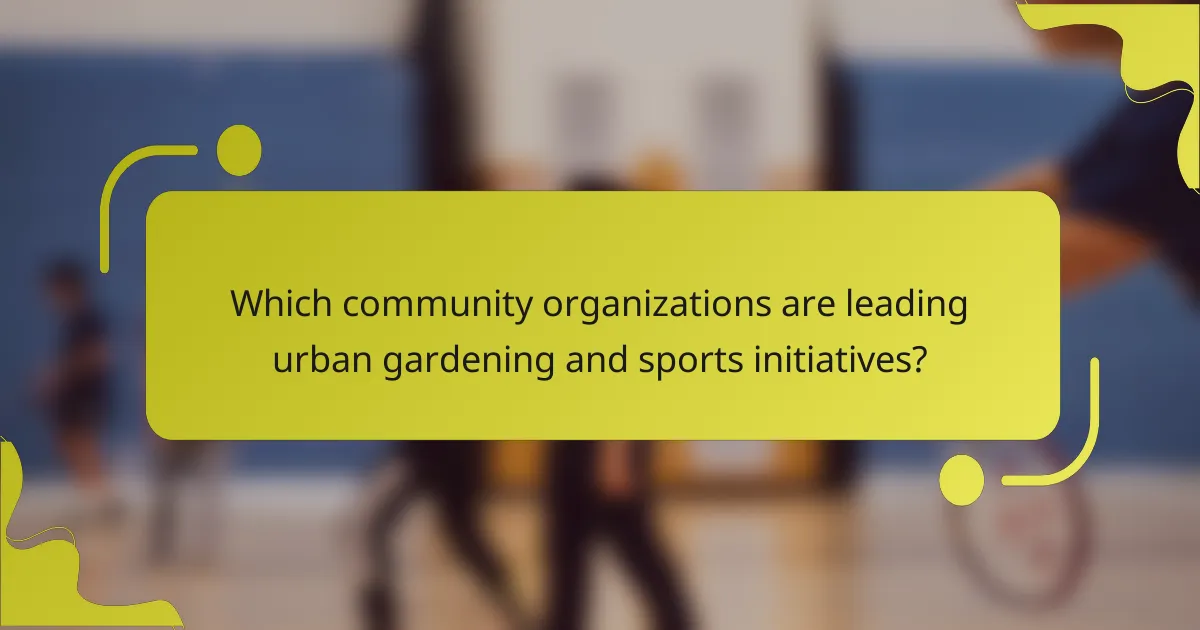
Which community organizations are leading urban gardening and sports initiatives?
Community organizations leading urban gardening and sports initiatives include local non-profits and grassroots groups. These organizations promote sustainability and community involvement through innovative programs. For example, the Urban Agriculture Coalition engages residents in gardening while providing sports activities to enhance community health. Additionally, the Green Spaces Initiative focuses on creating green spaces that support both gardening and recreational sports. These efforts foster community engagement, improve urban environments, and promote healthy lifestyles.
What partnerships exist between sports clubs and gardening organizations?
Sports clubs partner with gardening organizations to promote sustainability and community engagement. These collaborations often involve urban gardening initiatives that benefit local communities. For example, clubs may host events that encourage members to participate in gardening activities, fostering teamwork and environmental awareness. Additionally, some sports clubs support gardening projects through funding or volunteer efforts, enhancing their community presence and commitment to sustainability. These partnerships create a positive impact by improving urban green spaces while promoting healthy lifestyles among participants.
How do local governments support these initiatives?
Local governments support urban gardening initiatives through funding, resources, and community programs. They provide grants to local organizations, ensuring access to materials and training. Additionally, they promote policies that encourage green spaces, fostering community engagement and sustainability. Collaborations with schools and nonprofits enhance educational outreach, making gardening accessible to diverse populations. These initiatives not only improve urban environments but also strengthen community bonds.

What challenges do urban gardening initiatives face in urban sports contexts?
Urban gardening initiatives in urban sports contexts face several challenges, including limited space, community engagement, and resource allocation. Limited space restricts the ability to grow diverse crops, impacting food security. Community engagement varies, as not all residents may prioritize or understand the benefits of urban gardening. Resource allocation often falls short, with insufficient funding and materials hindering project sustainability. Additionally, regulatory barriers can complicate the establishment of gardens in public spaces, creating further obstacles.
How can funding and resources be secured for these initiatives?
Securing funding and resources for urban gardening initiatives involves strategic partnerships and community involvement. Organizations can collaborate with local businesses, government grants, and non-profits to gather necessary support. Engaging community members boosts volunteer efforts and attracts donations. Additionally, applying for environmental and sustainability grants can provide crucial financial backing. Establishing clear project goals and demonstrating potential community benefits can enhance funding applications.
What barriers exist to participation in urban gardening through sports?
Barriers to participation in urban gardening through sports include lack of access, limited knowledge, and community engagement challenges. These factors hinder individuals from fully engaging in sustainable initiatives. Access to resources like land and tools is often restricted in urban areas. Additionally, inadequate awareness of gardening techniques limits participation. Community involvement is crucial; without strong networks, initiatives struggle to gain traction.
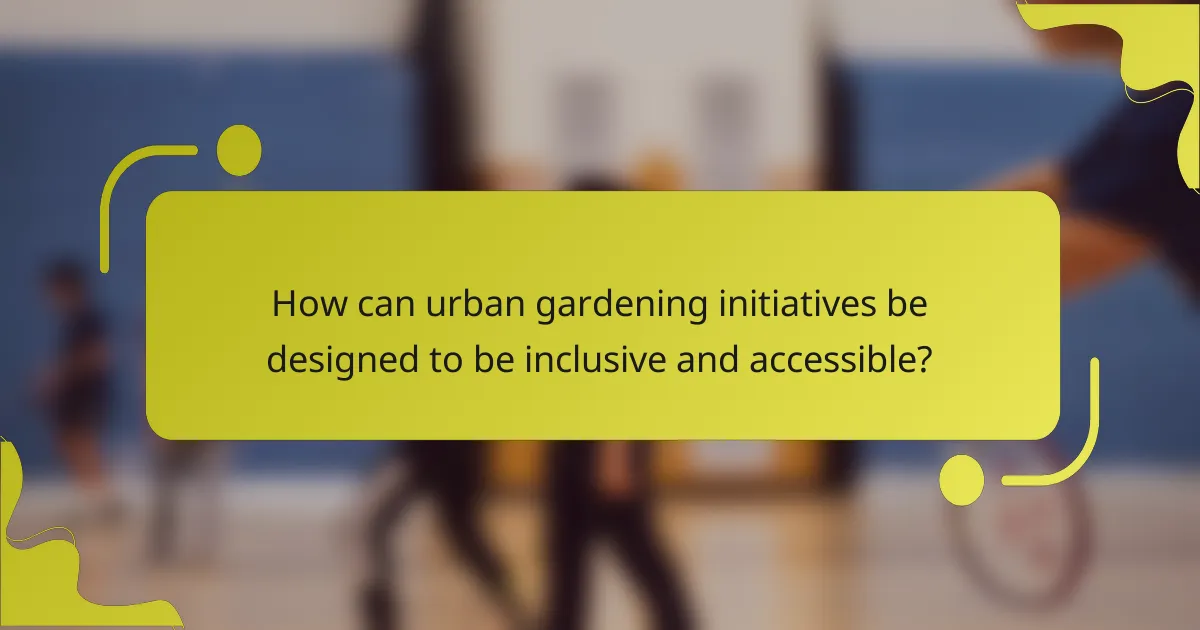
How can urban gardening initiatives be designed to be inclusive and accessible?
Inclusive and accessible urban gardening initiatives can be designed by prioritising community involvement and diverse participation. Engaging local residents in the planning process ensures that their needs and preferences are met. Providing resources such as raised beds and adaptive tools accommodates individuals with varying physical abilities. Additionally, offering educational workshops in multiple languages fosters inclusivity among diverse populations. Establishing partnerships with local organizations can enhance outreach and support, ensuring that initiatives reach underrepresented communities. By integrating these strategies, urban gardening can become a platform for community engagement and sustainability.
Which strategies encourage diverse community participation?
Strategies that encourage diverse community participation include fostering inclusive spaces, promoting local leadership, and integrating cultural practices. Engaging residents through urban gardening initiatives enhances social cohesion and environmental awareness. Collaborative projects empower individuals, allowing them to contribute their unique skills and perspectives. As a result, these initiatives build a stronger, more resilient community.
What role does education play in promoting urban gardening through sports?
Education plays a crucial role in promoting urban gardening through sports by fostering community involvement and awareness. Educational programs linked to urban sports teach participants about sustainability and gardening practices. These initiatives often engage youth, encouraging them to cultivate gardens while participating in sports, thus merging physical activity with environmental stewardship. As a result, community members become more invested in local food systems, enhancing food security and promoting healthy lifestyles. Furthermore, educational workshops can provide practical skills, empowering individuals to create and maintain their own urban gardens, contributing positively to urban ecosystems.
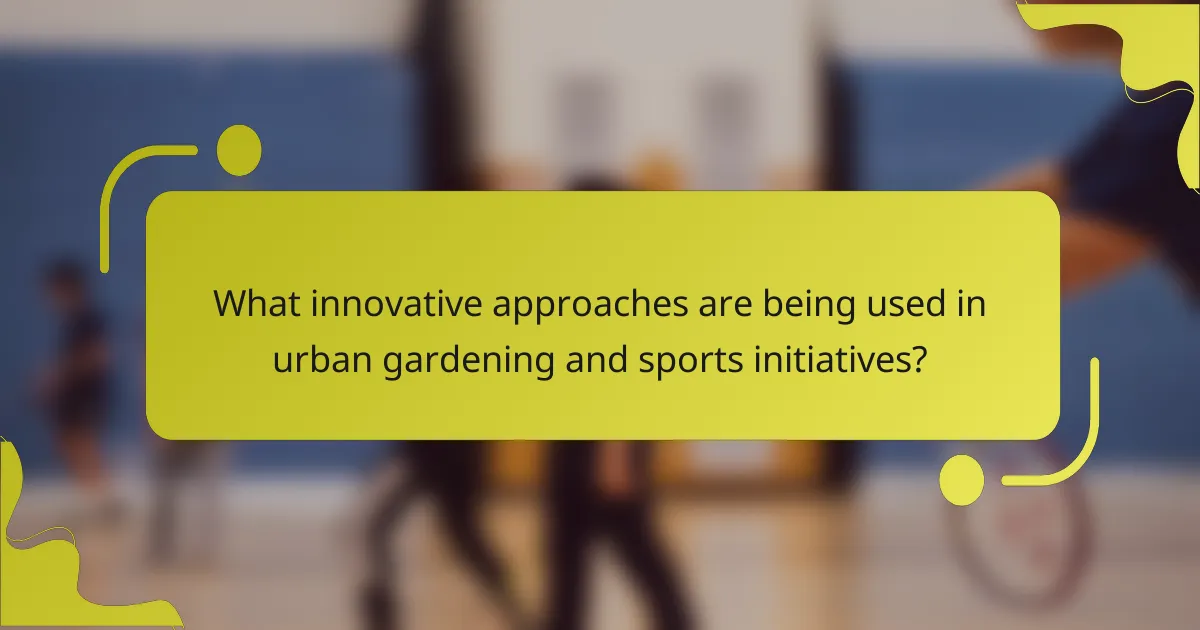
What innovative approaches are being used in urban gardening and sports initiatives?
Innovative approaches in urban gardening and sports initiatives include integrating green spaces into athletic facilities, promoting community-led gardening projects, and utilizing vertical gardening techniques to maximize limited urban space. These strategies enhance community engagement and promote sustainability. For example, projects like community gardens near sports venues foster local participation and provide fresh produce. Additionally, urban sports events often incorporate educational elements about gardening and sustainability, creating a holistic experience for participants.
How is technology enhancing urban gardening efforts in sports communities?
Technology enhances urban gardening efforts in sports communities by facilitating collaboration, optimizing resource use, and promoting sustainability. Mobile apps connect community members, enabling them to share gardening tips and resources. Smart sensors monitor soil health and moisture levels, ensuring efficient water usage. Drones assist in mapping available spaces for gardening, maximizing land use. Online platforms promote awareness of urban gardening initiatives, encouraging participation in local sports events focused on sustainability. These advancements foster community engagement while contributing to healthier urban environments.
Which creative designs are being implemented in urban gardening spaces?
Creative designs in urban gardening spaces focus on sustainability and community engagement. Vertical gardens, edible landscapes, and hydroponic systems are popular implementations. These designs maximize space and enhance biodiversity, promoting local food production. Community art installations and interactive workshops further engage residents, fostering a sense of ownership and collaboration.
What examples of successful urban gardening and sports initiatives can be highlighted?
Successful urban gardening and sports initiatives include community gardens that promote health and fitness. For example, the Brooklyn Grange in New York City combines urban farming with fitness classes to engage locals. Another initiative is the Edible Schoolyard Project, which integrates gardening into school sports programs, teaching children about nutrition and teamwork. Additionally, the Growing Power organization in Milwaukee connects urban agriculture with youth sports, fostering community involvement and sustainable practices. These initiatives highlight the synergy between urban gardening and sports, enhancing community well-being.
How can these initiatives be scaled or replicated in other communities?
Scaling urban gardening initiatives in other communities involves replicating successful models tailored to local needs. Key strategies include forming partnerships with local organizations, engaging community members through workshops, and utilizing available resources effectively. For instance, the integration of educational programs can enhance community involvement. Additionally, adapting gardening techniques to suit different climates and urban layouts is crucial. Sharing success stories and best practices through online platforms can inspire other communities to adopt similar initiatives.
What are the best practices for integrating urban gardening into sports programs?
Integrating urban gardening into sports programs enhances community engagement and promotes sustainability. Best practices include collaboration with local gardening organizations, incorporating gardening activities into training schedules, and creating educational workshops on sustainable practices. Additionally, utilizing sports facilities for community gardening events fosters inclusivity and strengthens community ties. Regular feedback from participants can help tailor initiatives to meet community needs effectively.
What common mistakes should be avoided in urban gardening initiatives?
Common mistakes in urban gardening initiatives include poor site selection, inadequate community involvement, neglecting soil health, and lack of clear goals. These errors can hinder sustainability and community engagement.
1. Poor site selection: Choosing locations with insufficient sunlight or poor drainage can limit plant growth.
2. Inadequate community involvement: Failing to engage local residents reduces support and interest.
3. Neglecting soil health: Ignoring soil testing and amendment can lead to unproductive gardens.
4. Lack of clear goals: Without defined objectives, initiatives may lack direction and effectiveness.
